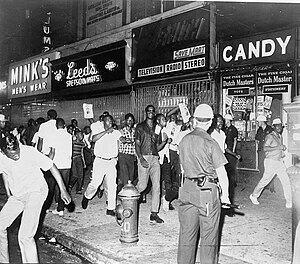During the turn of the 20th century, social and
economical conditions made seem as if blacks would never gain a decent foothold
in American society. Race riots before
the 1960s primarily took the form of white supremacists rebelling against
blacks trying to survive the tumultuous conditions of the time. Minor violent clashes against blacks were
commonplace; lynching was still a routine practice in the early 20th
century. While most famous riots stemmed
from alleged criminal activity, it certainly did not take much to spark all-out
war between white and black communities.
One of Chicago's most famous riots started in 1919 when an African
American teenager was drowned for crossing the invisible threshold that
separated the "white" beach from the "black" beach. What followed was seven days of shootings,
arsons, and beatings that left 15 whites and 23 blacks dead and 537
injured. As a result of post-WWII
housing projects and developments, whites gathered in the thousands to protest
African American professionals seeking improved housing beyond the reaches of
the ghetto. White race riots against
African Americans even spilled over into the early 1960s, when Southern
segregationalists rioted after a black student, James Meredith, was admitted at
the University of Mississippi in 1962.
By the year of 1964, blacks had seen generations of unrelenting hatred
from whites, but the outset of the Civil Rights Movement encouraged blacks to
take drastic steps in order to fight back.
1919 Omaha Race Riot. A crowd stands around the burning corpse of Will Brown, who was accused of assaulting a white woman
1921 Black Wall Street Riot. A dead black man is put on display for everyone to see







